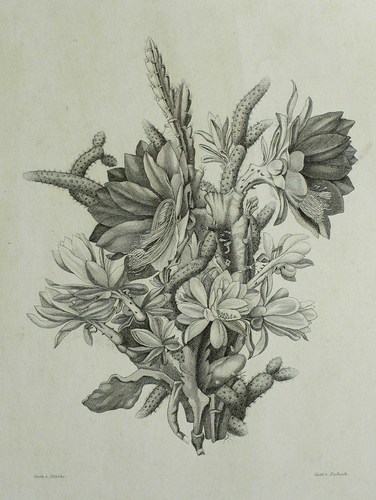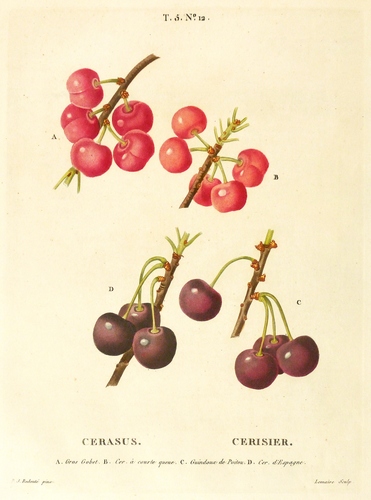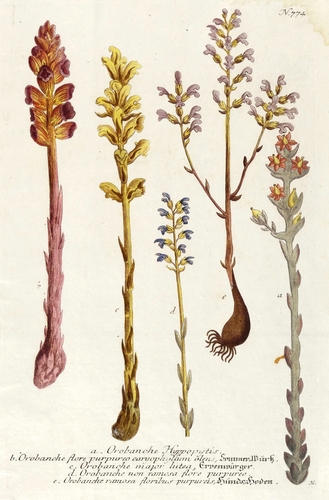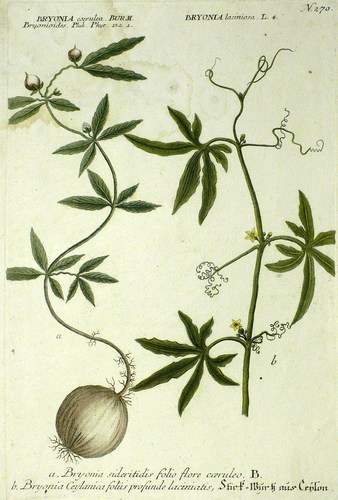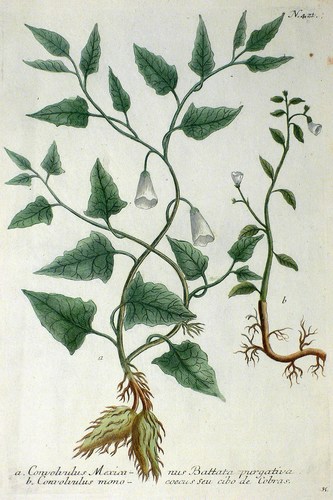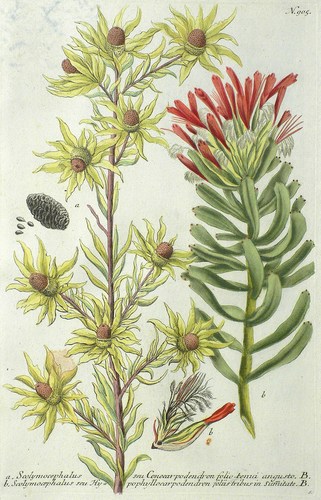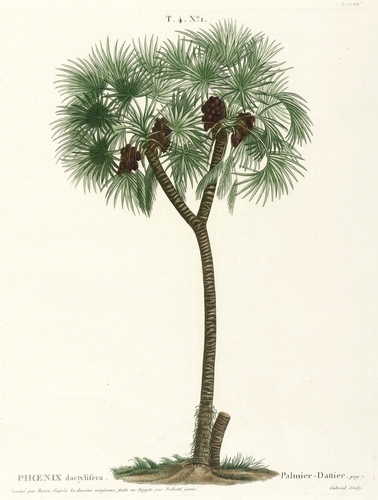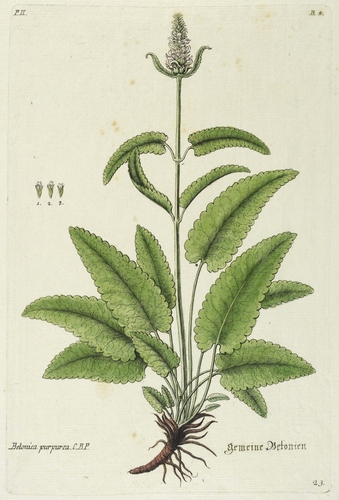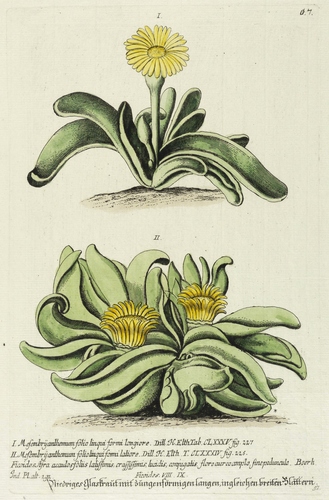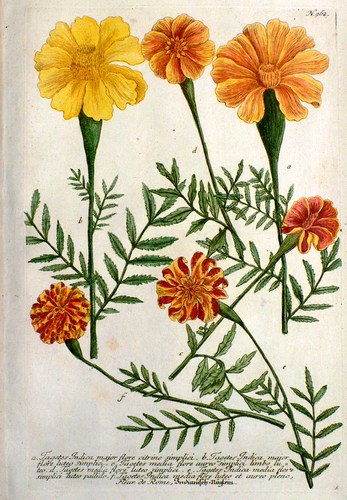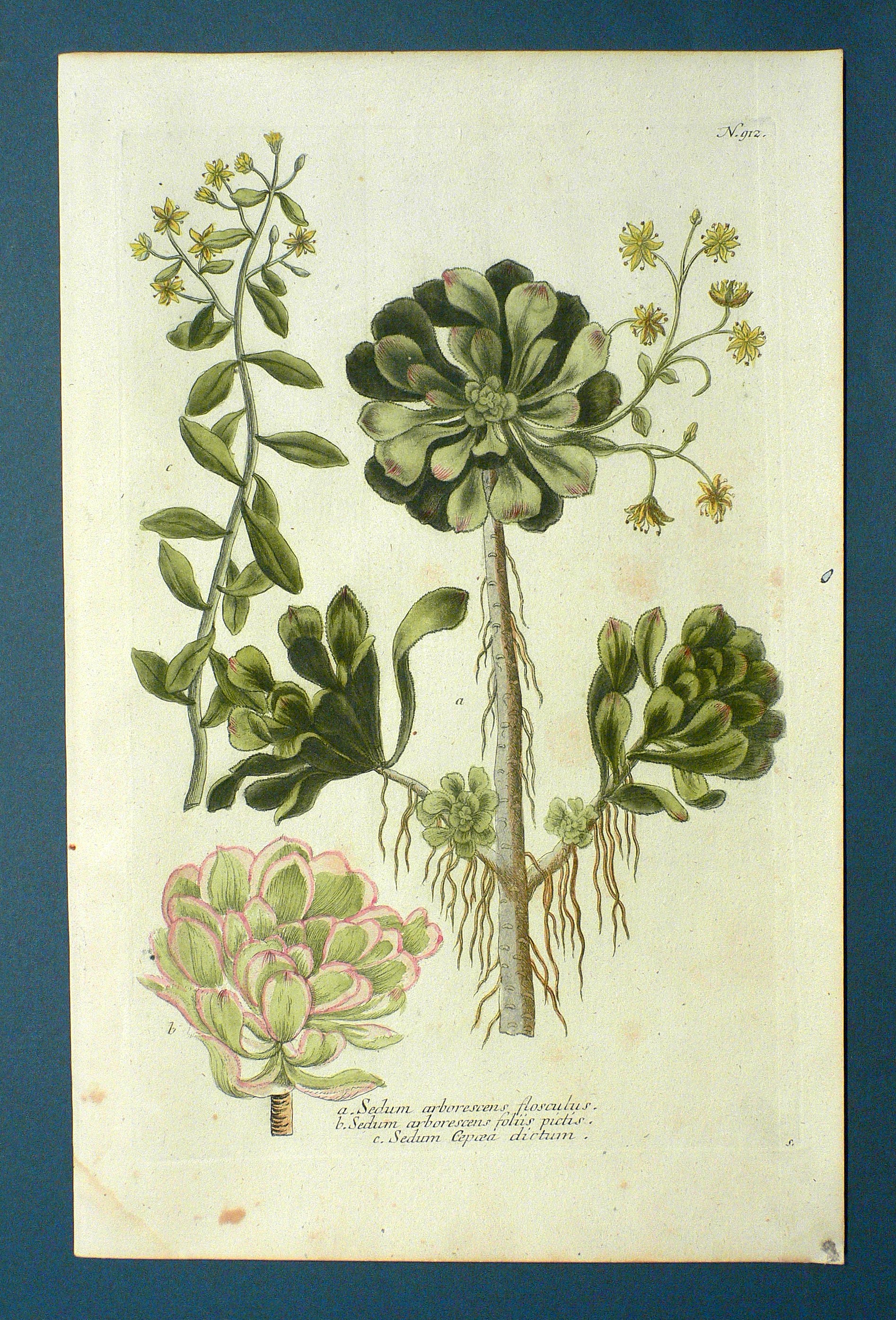

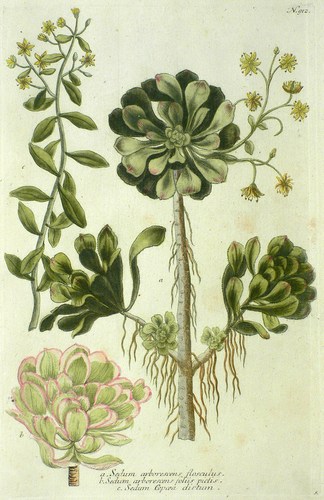
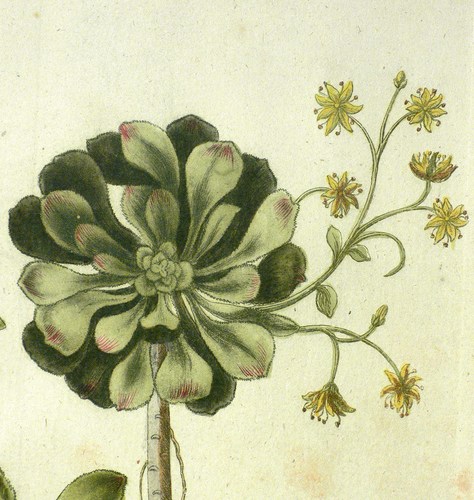
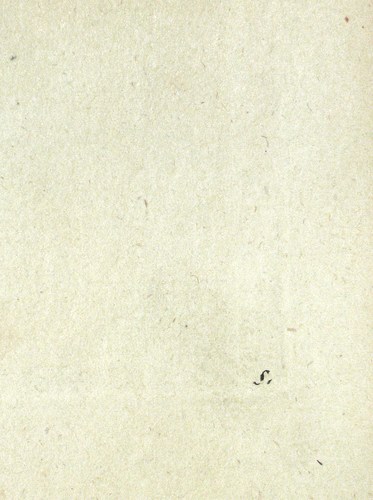
Dickblattgewächse (Crassulaceae). – Sedum. – Weinmann. – „Sedum”.
1745. Kupferstich / Mezzotinto, alt koloriert. – Historische Pflanzendarstellung, von Bartholomäus Seutter. – 32,9 x 21,2 cm (Darstellung / Platte), 38,5 x 25 cm (Blatt).
6,00 € Germany 14,00 € Europe 32,00 € worldwide
Aus: Johann Wilhelm Weinmann, Phytanthoza-Iconographia Oder Eigentliche Vorstellung Etlicher Tausend, So wohl Einheimisch- als Ausländischer, aus allen vier Welt-Theilen, in Verlauf vieler Jahre (...) gesammelter Pflantzen, Bäume, Stauden, Kräuter, Blumen, Früchten und Schwämme (Regensburg: Lentz 1745), Bd. IV. – Rechts unten Signatur, rechts oben Tafel-Nr. "912", unterhalb mittig ausführliche Inschrift. – Bei der Herstellung der Tafeln arbeiteten die Augsburger Künstler Bartholomäus Seutter, Johann Jakob Haid und Johann Elias Ridinger zusammen. Die Kupfer wurden in einer für die Zeit revolutionären Weise farbig gedruckt und sodann partiell von Hand koloriert. Dabei fand der von Seutter weiterentwickelte Mezzotinto-Farbdruck des Niederländers Johannes Teyler Anwendung. – Das kräftige Büttenpapier verinzelt leicht fleckig. Sonst guter Erhaltungszustand.
Bartholomäus Seutter (1678 Augsburg - 1754 Augsburg). Auch Bartholomäus Seuter. Deutscher Goldschmied, Emailleur, Porzellan- und Fayencemaler, Kupferstecher, Schabkünstler und Verleger. Bemalte u.a. die Keramiken seines Bruders, des Augsburger Goldschmieds und Feuermalers Abraham Seuter (1699–1747). Übernahm und verbesserte das Mezzotinto-Farbdruckverfahren des Niederländers Johannes Teyler. Lieferte in Zusamenarbeit mit Johann Jakob Haid und Johann Elias Ridinger die Platten zu Johann Wilhelm Weinmanns Phytanthoza-Iconographia (1737-45).
SukkulentenAugsburger BarockHistorische PflanzendarstellungDickblattgewächse (Crassulaceae)Sedum (Gattung)
1745. Kupferstich / Mezzotinto, alt koloriert. – Historische Pflanzendarstellung, von Bartholomäus Seutter. – 32,9 x 21,2 cm (Darstellung / Platte), 38,5 x 25 cm (Blatt).
100,00 €
incl. VAT excl. Shipping
incl. VAT excl. Shipping
6,00 € Germany 14,00 € Europe 32,00 € worldwide
Aus: Johann Wilhelm Weinmann, Phytanthoza-Iconographia Oder Eigentliche Vorstellung Etlicher Tausend, So wohl Einheimisch- als Ausländischer, aus allen vier Welt-Theilen, in Verlauf vieler Jahre (...) gesammelter Pflantzen, Bäume, Stauden, Kräuter, Blumen, Früchten und Schwämme (Regensburg: Lentz 1745), Bd. IV. – Rechts unten Signatur, rechts oben Tafel-Nr. "912", unterhalb mittig ausführliche Inschrift. – Bei der Herstellung der Tafeln arbeiteten die Augsburger Künstler Bartholomäus Seutter, Johann Jakob Haid und Johann Elias Ridinger zusammen. Die Kupfer wurden in einer für die Zeit revolutionären Weise farbig gedruckt und sodann partiell von Hand koloriert. Dabei fand der von Seutter weiterentwickelte Mezzotinto-Farbdruck des Niederländers Johannes Teyler Anwendung. – Das kräftige Büttenpapier verinzelt leicht fleckig. Sonst guter Erhaltungszustand.
Bartholomäus Seutter (1678 Augsburg - 1754 Augsburg). Auch Bartholomäus Seuter. Deutscher Goldschmied, Emailleur, Porzellan- und Fayencemaler, Kupferstecher, Schabkünstler und Verleger. Bemalte u.a. die Keramiken seines Bruders, des Augsburger Goldschmieds und Feuermalers Abraham Seuter (1699–1747). Übernahm und verbesserte das Mezzotinto-Farbdruckverfahren des Niederländers Johannes Teyler. Lieferte in Zusamenarbeit mit Johann Jakob Haid und Johann Elias Ridinger die Platten zu Johann Wilhelm Weinmanns Phytanthoza-Iconographia (1737-45).
SukkulentenAugsburger BarockHistorische PflanzendarstellungDickblattgewächse (Crassulaceae)Sedum (Gattung)
You might also like the following works:
Kakteen. – Blüten verschiedener Kakteen. – nach Johann Friedrich Starke „Cactus Blüthen”.
1829. Kupferstich / Linienstich. – Von Christian Gottfried Zschoch, nach Johann Friedrich Starke. – 29,0 x 23,9 cm (Darstellung / Platte), 46 x 30 cm (Blatt),
1829. Kupferstich / Linienstich. – Von Christian Gottfried Zschoch, nach Johann Friedrich Starke. – 29,0 x 23,9 cm (Darstellung / Platte), 46 x 30 cm (Blatt),
60,00 €
Obst. – Kirschen. – nach Pierre-Joseph Redouté „Cerasus. Cerisier”.
1812. Farbkupferstich / Punktstich. – Von J. Lemaire, nach Pierre-Joseph Redouté. – 30,8 x 22,8 cm (Darstellung / Platte), 38,5 x 29,5 cm (Blatt),
1812. Farbkupferstich / Punktstich. – Von J. Lemaire, nach Pierre-Joseph Redouté. – 30,8 x 22,8 cm (Darstellung / Platte), 38,5 x 29,5 cm (Blatt),
160,00 €
Sommerwurzgewächse. – Sommerwurzen. – Weinmann. – „Sommer-Wurtz. Ervenwürger. Hunds-Hoden”.
1742. Kupferstich / Mezzotinto, alt koloriert. – Historische Pflanzendarstellung, von Johann Jakob Haid. – 33,0 x 21,3 cm (Darstellung / Platte), 38,5 x 24,5 cm (Blatt),
1742. Kupferstich / Mezzotinto, alt koloriert. – Historische Pflanzendarstellung, von Johann Jakob Haid. – 33,0 x 21,3 cm (Darstellung / Platte), 38,5 x 24,5 cm (Blatt),
150,00 €
Zaunrüben. – Bryonia. – Weinmann. – „Stick-Wurtz aus Ceylon”.
1739. Kupferstich / Mezzotinto, alt koloriert. – 32,5 x 21,4 cm (-), 38,5 x 25 cm (Blatt),
1739. Kupferstich / Mezzotinto, alt koloriert. – 32,5 x 21,4 cm (-), 38,5 x 25 cm (Blatt),
80,00 €
Gemüse. – Süßkartoffel. - Batate. – Weinmann. – „Convolvulus Mexicanus Battata”.
1739. Kupferstich / Mezzotinto, alt koloriert. – Von Johann Jakob Haid. – 32,0 x 21,2 cm (-), 38,5 x 23,5 cm (Blatt),
1739. Kupferstich / Mezzotinto, alt koloriert. – Von Johann Jakob Haid. – 32,0 x 21,2 cm (-), 38,5 x 23,5 cm (Blatt),
180,00 €
Silberbaumgewächse / Protea. – Weinmann. – „Scolymocephalus seu Conocarpodendron. Scolymocephalus seu Hypophyllocarpodendron”.
1742. Kupferstich / Mezzotinto, alt koloriert. – Von Bartholomäus Seutter. – 33,2 x 21,1 cm (-), 39 x 24,5 cm (Blatt),
1742. Kupferstich / Mezzotinto, alt koloriert. – Von Bartholomäus Seutter. – 33,2 x 21,1 cm (-), 39 x 24,5 cm (Blatt),
130,00 €
Palmen. – Echte Dattelpalme. – nach Pierre-Joseph Redouté „Phoenix dactylifera. Palmier-Dattier”.
1801-1819. Farbkupferstich / Punktstich, auf feinem Velin. – Historische Pflanzendarstellung, von Louis Gabriel, nach Pierre-Joseph Redouté. – 30,8 x 23,1 cm (Darstellung / Platte), 50 x 33 cm (Blatt),
1801-1819. Farbkupferstich / Punktstich, auf feinem Velin. – Historische Pflanzendarstellung, von Louis Gabriel, nach Pierre-Joseph Redouté. – 30,8 x 23,1 cm (Darstellung / Platte), 50 x 33 cm (Blatt),
2.600,00 €
Lippenblütler. – Echte Betonie (Betonica officinalis). – „Betonica purpurea. C.B.P. Gemeine Betonien”.
Um 1760. Kupferstich / Linienstich, alt koloriert. – Historische Pflanzendarstellung. – 29,7 x 19,7 cm (Darstellung / Platte), 41 x 27 cm (Blatt),
Um 1760. Kupferstich / Linienstich, alt koloriert. – Historische Pflanzendarstellung. – 29,7 x 19,7 cm (Darstellung / Platte), 41 x 27 cm (Blatt),
120,00 €
Mittagsblumengewächse. – Mesembryanthemum. – „I. Mesembryanthemum folio linqui [...] Niedriges Glaskraut mit zungenförmigern langen, ingleichen breiten Blättern”.
Um 1760. Kupferstich / Linienstich, alt koloriert. – Historische Pflanzendarstellung. – 30,9 x 19,6 cm (Darstellung / Platte), 43,5 x 27,5 cm (Blatt),
Um 1760. Kupferstich / Linienstich, alt koloriert. – Historische Pflanzendarstellung. – 30,9 x 19,6 cm (Darstellung / Platte), 43,5 x 27,5 cm (Blatt),
120,00 €











